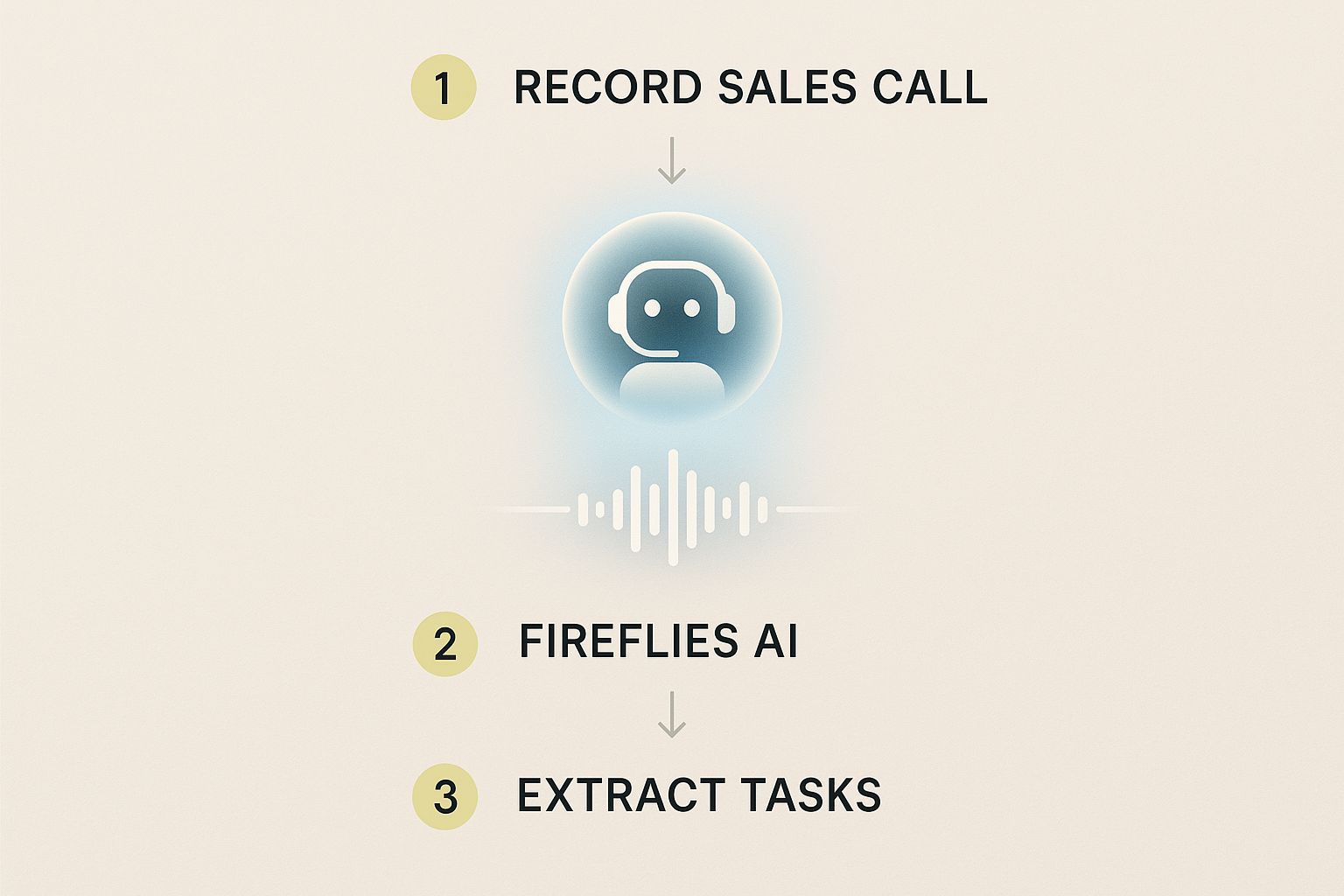
By integrating conversation intelligence tools like Gong and Fireflies.ai with your CRM, you can finally put your sales follow-up on autopilot. This isn't just a minor tweak; it's a powerful connection that turns spoken promises on calls into real, automatically-created tasks in your CRM. The result? No more manual data entry and no more missed opportunities.

Every sales pro knows the feeling. You’ve just finished a fantastic call, and now the race against the clock begins. You’re frantically trying to decipher your scribbled notes, recall the exact commitments made, and get everything into the CRM before those crucial details vanish from your memory.
This manual grind has serious hidden costs. It’s not just the time wasted on admin; it’s the golden opportunities that slip through the cracks when a follow-up is delayed, forgotten, or poorly executed. Inaccurate CRM data doesn't just look messy—it leads to misinformed sales strategies and a warped view of your pipeline's health.
The following table breaks down just how stark the difference is between the old way of doing things and the new, automated approach.
This isn't just about saving a few minutes here and there. It's about fundamentally changing how your sales team operates, freeing them up to focus on what they do best: selling.
Let's be honest: persistence is everything in sales, yet it's often the first thing to drop when people get busy. The numbers from the UK sales landscape paint a pretty clear picture. While 80% of sales require at least five follow-ups, a staggering 44% of reps give up after just one attempt. That gap represents a massive amount of lost revenue—money that a systematic follow-up process can easily reclaim.
This is where a system that basically writes your follow-ups for you becomes a game-changer. Conversation intelligence tools are making this a reality.
The goal here is to shift your team's energy away from soul-crushing admin and back to what actually moves the needle: building relationships and closing deals. This isn't about replacing talented salespeople; it's about amplifying their skills by getting the boring stuff out of their way.
Many growing agencies we work with find this shift incredibly powerful. It allows them to scale their sales operations without scaling their administrative headaches. You can check out more on that here: https://www.gentax.uk/who-we-help/agencies. It gives every rep the confidence that no promise will ever be forgotten again.
Before you can build a sales follow-up that practically writes itself, you need the right engine to power the whole operation. This isn’t just about picking the tool with the most features; it's a strategic choice between two excellent, but very different, platforms: Gong and Fireflies.ai.
Which one is right for you boils down to your team’s size, the complexity of your sales process, and of course, your budget.
Think of Gong as the heavy-duty, data-rich command centre for an enterprise sales force. It’s so much more than just a call transcription tool. Gong is a full-blown revenue intelligence platform built to dissect complex, multi-stakeholder deals. It serves up deep analytics on deal health, competitor mentions, and market trends, giving leadership a proper bird's-eye view of the entire sales pipeline.
For a team wrestling with six-figure contracts and long sales cycles, these insights are gold. Gong can automatically flag a deal that’s going cold based on conversational cues or tell you which value propositions are actually landing with C-level executives across hundreds of calls.
Gong really comes into its own in environments where understanding the tiny nuances of every interaction can make or break a deal. It’s built for scale and incredible depth.
In short, Gong is an investment in strategic insight. It’s less about simple task automation and more about understanding the "why" behind your sales performance to drive predictable revenue.
On the other side of the coin, you have Fireflies.ai. It's the agile, fast-moving alternative that’s perfect for small to medium-sized businesses (SMBs) and startups. Where Gong offers depth, Fireflies delivers speed, efficiency, and dead-simple integration.
Its core strength is its ability to accurately record, transcribe, and summarise meetings, making it ridiculously easy to turn conversations into actions.
Fireflies is less concerned with macro-level revenue trends and more focused on boosting individual and team productivity. For a fast-growing startup, being able to automatically log call notes, create tasks in a CRM, and share key moments with a single click is a massive win. Its lighter footprint and more accessible pricing make it an ideal starting point for teams who want to get automated without a huge initial investment.
Many startups find that managing finances efficiently is key, which makes choosing the right tools crucial. For more on this, you can explore our guide on the best cloud accounting software for startups.
This platform is ideal for teams that value speed and simplicity. It’s all about empowering every single rep to be more organised and responsive, ensuring no commitment ever gets missed. Ultimately, the choice isn't about which tool is "better," but which one aligns with your immediate goals—deep strategic analysis or rapid, streamlined execution.
You’ve picked your conversation intelligence platform – great. Now for the fun part: building the bridge to your CRM. This is where the real magic happens, turning spoken words on a call into structured, actionable tasks in your system, all without anyone lifting a finger.
Connecting Gong or Fireflies.ai to your CRM isn't just a technical box-ticking exercise. It’s about creating a rock-solid pipeline that makes sure no promise or follow-up item ever gets lost in translation. Think of it less like plugging in a cable and more like teaching two key team members how to speak the same language.
This diagram shows how it all starts. The AI listens to the call, pulls out the important bits, and gets them ready for the next step.

This is that crucial handoff from conversation to data, with the AI acting like a super-efficient assistant, isolating every commitment so it can be actioned.
The very first thing you need to do is authorise the connection between the two platforms. It’s a critical security step that gives one tool permission to read and write data in the other. Both Gong and Fireflies use a secure protocol called OAuth, which is just a fancy way of saying you never have to share your actual CRM password with them.
When connecting Gong to Salesforce, for instance, you'll be redirected to your Salesforce login page to approve a specific set of permissions. This usually covers things like:
It's a straightforward process, but there’s a common pitfall here. You absolutely must be logged in with an administrator account that has full permissions. I've seen it happen countless times where someone uses a standard user account, only to wonder why data isn't syncing properly weeks later.
My takeaway: Always use a CRM account with full admin rights for the initial integration. It ensures the connection has the scope it needs to access and update everything, saving you from frustrating data gaps down the road.
Getting this initial link right is the foundation of your entire automated follow-up system. For businesses looking to go even further, understanding the full scope of a technology transformation can unlock strategic advantages well beyond just sales.
With the connection live, you now need to play translator. This is where you tell the systems how to talk to each other by mapping data fields. When Gong spots a "competitor mention," where should that snippet of information actually live inside your CRM? You need to decide.
Let’s walk through a practical example using HubSpot:
Getting this mapping right is the difference between a cluttered, confusing CRM and a genuinely intelligent one that works for you, not against you.
Just creating a task for every single call isn’t the goal; that quickly turns into digital noise. The trick is to build rules that listen for specific, high-intent phrases—the kind of language that signals a genuine opportunity is taking shape.
Your first set of rules should be all about capturing direct commitments. Think of these as the low-hanging fruit of automation, turning spoken promises into concrete next steps in your CRM without anyone lifting a finger.
Take a classic scenario where a prospect is showing strong buying signals. You can set up a rule that listens for exactly what they say and then acts on it instantly.
This simple bit of automation makes sure one of the most critical follow-ups in any sales cycle is never, ever missed. You're not just creating another task; you're building a system of accountability that reacts at the speed of the conversation itself.
The objective is to translate verbal cues into structured data. When a prospect mentions a competitor, that's not just a conversation point—it's valuable intel that should be logged, tracked, and used to inform your sales strategy.
Once you've got the basics down, you can start building more advanced rules that fundamentally change how you manage your pipeline. These automations don't just capture tasks; they can update deal stages and flag important moments for the leadership team.
Imagine a discovery call where the conversation naturally shifts towards specific contract terms or implementation timelines. That's a huge tell—it signals the deal is moving past early-stage interest and into serious consideration.
Example Automation:
This does so much more than save a rep a few clicks. It ensures your pipeline is always accurate, giving leadership a true, real-time view of the business. As AI continues to evolve, the sophistication of these rules will only get better, making these tools even more intuitive. You can get a glimpse of what's on the horizon by exploring our guide on the release features and UK business use cases for upcoming AI models.
The most advanced tactic is to tap into sentiment analysis. Both Gong and Fireflies.ai can gauge the emotional tone of a conversation, flagging calls with negative sentiment, long customer monologues, or periods of low engagement. This turns your CRM from a passive database into a proactive sales coach.
A rule can be configured to sniff out at-risk deals. For instance, if a call has a high percentage of negative sentiment or the prospect brings up a bunch of unresolved objections, the system can flag it right away. This gives a manager the chance to step in with coaching or support before a small snag becomes a deal-breaker.

Setting up a system where sales follow-ups write themselves is a massive win, but how do you actually prove its value to the business? To really measure the return on investment (ROI), you have to move beyond gut feelings and dig into the cold, hard numbers.
This means tracking the key performance indicators (KPIs) that draw a direct line between your new automated workflows and tangible sales outcomes.
The right data tells a powerful story. By building a few simple dashboards in your CRM, you can visualise the improvements and show exactly how this new process is hitting the bottom line. It’s all about connecting the dots between less admin and more closed deals.
First, you need a baseline. Capture your team's performance before the automation goes live. Then, keep a close eye on these specific KPIs to see the change over time. These are the metrics that will give you a clear, quantitative look at your efficiency gains.
The move to integrate AI-driven platforms like Gong and Fireflies.ai with a CRM is fundamentally reshaping sales in the UK. Data shows that businesses using CRM systems are almost nine times more likely to beat their targets. On top of that, over 80% of sales teams using AI tools report increased revenue. You can dig into more of these 2025 B2B sales trends here.
Beyond the hard numbers, don't overlook the qualitative benefits. These are just as important for building a successful, sustainable sales culture and are often the things the team celebrates the most.
Cleaner CRM data leads to more accurate sales forecasting. When every commitment and next step is automatically logged, sales leaders can finally trust the pipeline data. That leads to better strategic decisions for the entire business.
And finally, think about your team's morale. When you remove the soul-crushing admin of manual data entry, you free up your reps to focus on what they do best—and what they actually enjoy—which is selling. This boost in job satisfaction often leads to higher retention, better performance, and a far more energised team.
Whenever you introduce a new system, especially one that automates a core sales activity, questions are bound to pop up. It’s completely normal. Getting your team comfortable with how it all works is the key to getting them to actually use it.
Let's walk through some of the most common queries I hear when teams start connecting tools like Gong or Fireflies.ai to their CRM.
One of the first things that always comes up is transcription accuracy. How good is it, really? Both platforms are impressively accurate, particularly when the audio quality is clean. To get the best results, just encourage your reps to use a decent microphone and try to keep background chatter to a minimum. You can even set up your rules to only trigger an automation if the transcription has a high confidence score, which neatly sidesteps any potential errors from a garbled call.
Another big one is how this fits into an existing, often highly customised, sales process.
Yes, absolutely. This is where these tools really shine. Both Gong and Fireflies.ai are built for deep integrations, letting you map call data, specific topics, and custom trackers directly to your custom fields in CRMs like Salesforce and HubSpot.
This means the automation moulds to your unique sales methodology. You’re not forced into some generic, out-of-the-box workflow that doesn't quite fit.
But what happens if an automation gets it wrong? It’s a smart move to ease into it. I always recommend starting with a notification-based system first—something simple like an email alert to the rep—before you switch on fully automated task creation. This gives your team a chance to see the triggers in action and, more importantly, to build trust in the system.
The goal here isn't to build a rigid, hands-off machine from day one. It's to create a productivity tool that genuinely saves time and kills admin—not a surveillance tool. When your reps see it saving them hours every single week, they won't just adopt it; they'll wonder how they ever managed without it.
For more practical tips on optimising your business processes, we cover a whole range of topics over on the Gentax UK blog. Framing this as a helping hand—a way to get a sales follow-up that practically writes itself—is how you get everyone on board.
Ready to transform your business's financial operations with the same efficiency? GenTax Accountants leverages technology to provide clear, actionable insights for UK businesses. Discover how we can help you grow.